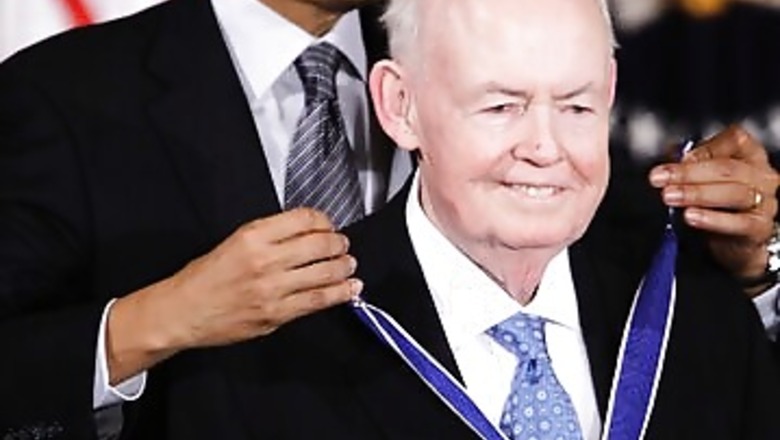
views
WASHINGTON: John Sweeney, who spent 14 years steering the AFL-CIO through a time of declining union membership and rising internal dissent, has died. He was 86.
He died on Monday, AFL-CIO national media manager Carolyn Bobb said. The cause of his death wasn’t immediately disclosed.
Sweeney was credited with transforming the nations largest labor federation into a political powerhouse more firmly aligned with the Democratic Party, as well as with civil rights, environmental and anti-poverty groups.
After stepping down as president of the labor federation in 2009, Sweeney served as the AFL-CIOs president emeritus, offering advice to the groups executive council, delivering speeches and taking on other discrete assignments.
The AFL-CIO’s current president, Richard Trumka, said of Sweeney in a statement: John was a great leader and true innovator, driving the labor movement forward. We stand on that foundation today as we take on the challenges of inequality, systemic racism and much more.
Born in New York City, Sweeney was the son of working-class Irish immigrants, his father a bus driver and his mother a maid. His mothers job cleaning houses made him sympathetic to the plight of low-wage workers, while his interest in organized labor grew during trips to union meetings with his father.
Growing up, I saw what the union meant for my father, Sweeney said in a 2013 speech. The union won him the wage increases that let him save up $5,000 to buy a home outside the city, in a promised land called Yonkers.
After graduating from Iona College in New Rochelle, New York, Sweeney started work as a clerk for IBM. But he soon took a pay cut to become a researcher at the International Ladies Garment Workers Union.
Sweeney later moved to the Service Employees International Union, becoming the head of a 70,000-member New York City local. He became president of the entire union in 1980, nearly doubling its membership over the next 15 years from 625,000 to 1.1 million. His successes included the rowdy Justice for Janitors organizing campaign, though much of the SEIUs growth came through mergers with smaller unions.
In 1995, Sweeney and several other union presidents unhappy with what they saw as the AFL-CIOs lackluster leadership forced the resignation of AFL-CIO President Lane Kirkland. Sweeney later ran for the post and defeated Kirklands hand-picked successor, Thomas Donahue, in the federations first contested election.
I have deep suspicions that we are becoming irrelevant to many of our own members, Sweeney complained in surprisingly blunt terms during a 1995 speech.
When he came into the office, union membership had already shrunk to about 15% of the nations workforce. He pledged to beef up organizing and rebuild unions into the force they were in the 1950s, when about 1 in 3 workers was in a union.
Sweeney did build up the AFL-CIOs political arm into a more effective machine for electing union-friendly officials at the federal, state and local level. The federation launched voter registration drives and expanded get-out-the vote efforts. Sweeney also started Working America, an AFL-CIO affiliate for people who didn’t have a union at work. It now boasts more than 3 million members.
But overall union membership continued to decline on Sweeneys watch, as the nation lost millions of manufacturing jobs and employers grew more resistant to union organizers. The losses led to more frustration by leaders who believed politics had become paramount at the expense of organizing new workers. The discontent boiled over after President George W. Bush was reelected in 2004, despite the millions of dollars unions had spent trying to help Democratic presidential candidate John Kerry.
In 2005, several unions, led by the Teamsters and Service Employees, left the AFL-CIO to form a rival federation called Change to Win. The move damaged the AFL-CIOs political heft and sapped millions of dollars in dues from its budget.
Despite the rift, Sweeney was reelected to another four-year term as president of the AFL-CIO. He was seen as a stabilizing force for the federation of 57 unions representing about 9 million workers.
I loved what I did, he said in a 2011 interview upon being awarded the Presidential Medal of Freedom, the nations highest civilian honor. I told my kids all the time how happy I was with my work. And, sure, there was a strike once in a while or something. That was really troubling. But, for the most part, satisfying working people was a mission that I had.
Sweeney is survived by his son, his daughter and a granddaughter.
___
Biographical material in this story was written by former Associated Press writer Sam Hananel.
Disclaimer: This post has been auto-published from an agency feed without any modifications to the text and has not been reviewed by an editor
Read all the Latest News, Breaking News and Coronavirus News here


















Comments
0 comment